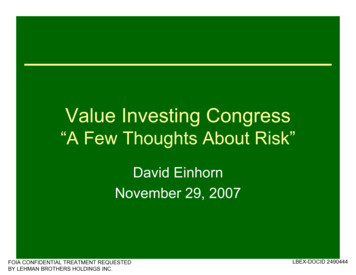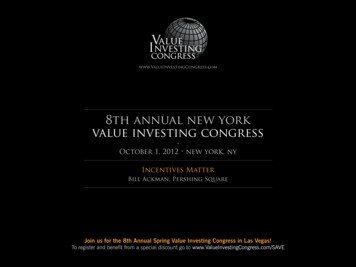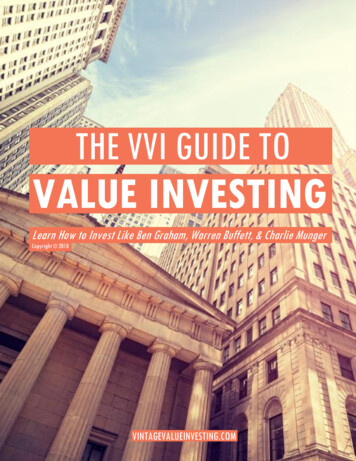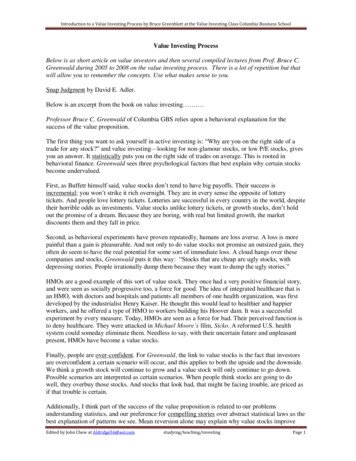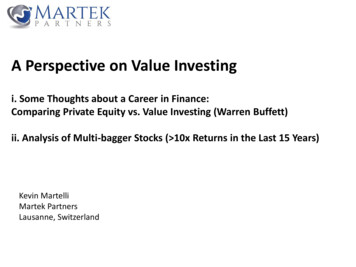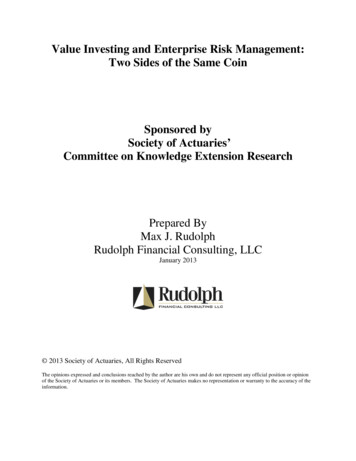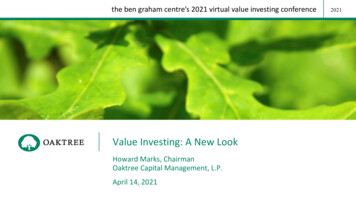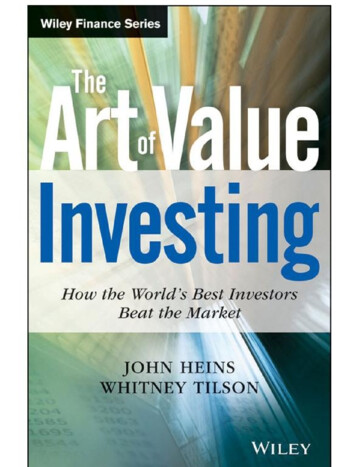
Transcription
ContentsCoverSeriesTitle PageCopyright
IntroductionChapter 1: “AllSensible Investing IsValue Investing”WHAT ITMEANS TO BEA VALUEINVESTORDOES QUALITY
MATTER?THE VALUE OFGROWTHTHE VALUEMINDSETPart One: Field ofPlayChapter 2: Circle of
CompetenceTHE RIGHTSIZEINDUSTRYPREFERENCEWHERE IN THEWORLD?Chapter 3: DeficientMarket Hypothesis
THE HUMANELEMENTIT'S A MATTEROF TIMEChapter 4: FertileGroundIN SEARCH OFUNCERTAINTYSPECIAL
SITUATIONSOPERATINGTURNAROUNDSChapter 5: GeneratingIdeasBEHIND THESCREENFOLLOW THELEAD
RELIABLESOURCESPart Two:Building the CaseChapter 6: CuttingThrough the NoiseSECOND-
ITYMEANS
CRUNCHINGTHE NUMBERSWHAT COULDGO WRONG?FROM THE TOPCATALYSTSGETTING ITDONEORGANIZINGPRINCIPLES
Chapter 7: Getting toYesCASH (FLOW)IS KINGMULTIPLEANGLESTHEINFORMEDBUYERMODEL
BEHAVIORPLAYING THEODDSTHEORIES OFRELATIVITYPULLING THETRIGGERPart Three:
ActiveManagementChapter 8: ThePortfolioCONCENTRATIOVERSUSDIVERSIFICATIOTHE SIZE THAT
FITSCOGNIZANCEOFCORRELATIONChapter 9: Playing theHandTRADINGMENTALITYDEALING WITH
ADVERSITYTAKING ASTANDATTRACTINGACTIVISTS'ATTENTIONChapter 10: GuardingAgainst RiskMARGIN OF
SAFETYBUILDING APOSITIONCASHMANAGEMENTMIDAS TOUCHHEDGING BETSChapter 11: Makingthe Sale
WHY TO SELLSELLING BYTHE NUMBERSGETTING THETIMING RIGHTSALE PROCESSPart Four: OfSound Mind
Chapter 12: Of UALSTUDENTTO ERR ISHUMAN
BE EVER SOHUMBLEThe Final WordAbout the AuthorsIndex
Founded in 1807, John Wiley& Sons is the oldestindependentpublishingcompany in the United States.With offices in NorthAmerica, Europe, Australiaand Asia, Wiley is globallycommitted to developing andmarketing print and electronicproducts and services for ourcustomers' professional andpersonal knowledge andunderstanding.
The Wiley Finance seriescontainsbookswrittenspecifically for finance andinvestment professionals aswellassophisticatedindividual investors and theirfinancial advisors. Booktopics range from portfoliomanagement to e-commerce,risk management, financialengineering, valuation andfinancial instrument analysis,as well as much more.
For a list of available titles,visit our Web site atwww.WileyFinance.com.
Coverimage: iStockphoto.com/CandiceCusackCover design: Leiva-SposatoCopyright 2013 by ValueInvestor Media, Inc. Allrights reserved.Published by John Wiley &Sons, Inc., Hoboken, NewJersey.Published simultaneously inCanada.
No part of this publicationmay be reproduced, stored ina retrieval system, ortransmitted in any form or rding,scanning,orotherwise,exceptaspermitted under Section 107or 108 of the 1976 UnitedStates Copyright Act, withouteither the prior writtenpermission of the Publisher,
or authorization throughpayment of the appropriateper-copy fee to the CopyrightClearance Center, Inc., 222Rosewood Drive, Danvers,MA 01923, (978) 750-8400,fax (978) 646-8600, or on theWeb at www.copyright.com.Requests to the Publisher forpermissionshouldbeaddressed to the PermissionsDepartment, John Wiley &Sons, Inc., 111 River Street,
Hoboken, NJ 07030, (201)748-6011, fax (201) t of Liability/Disclaimerof Warranty: While thepublisher and author haveused their best efforts inpreparing this book, theymake no representations orwarranties with respect to theaccuracy or completeness ofthe contents of this book and
specifically disclaim anyimpliedwarrantiesofmerchantability or fitness fora particular purpose. Nowarranty may be created orextendedbysalesrepresentatives or writtensales materials. The adviceand strategies containedherein may not be suitable foryour situation. You shouldconsult with a professionalwhere appropriate. Neither
the publisher nor author shallbe liable for any loss of profitor any other commercialdamages, including but notlimited to special, incidental,consequential,orotherdamages.For general information onour other products andservices or for technicalsupport, please contact ourCustomer Care Departmentwithin the United States at
(800) 762-2974, outside theUnited States at (317) 5723993 or fax (317) 572-4002.Wiley publishes in a varietyof print and electronicformats and by print-ondemand.Somematerialincluded with standard printversions of this book may notbe included in e-books or inprint-on-demand. If this bookrefers to media such as a CDor DVD that is not included
in the version you purchased,you may download thismaterialathttp://booksupport.wiley.com.For more information 7977-3(Hardcover)
-1-118-25863-7978-1-118-23396-2
IntroductionWhen we launched thenewsletter Value InvestorInsight in early 2005, ourmotivation was not to tout the“10 Best Stocks to Buy Now”or peddle a proprietarysystem that would “TripleYour Money in Six Months!”Primarily through two in-
depth interviews with highlysuccessful money managers,our goals for each issue havebeen to deliver not onlytimely investment ideas, butalso timeless wisdom aboutthe craft of investing. To thatend, our Value InvestorInsight interviews explore thefull spectrum of stockinvesting: from the definitionof an underlying philosophy,to the identification of
potential ideas, the researchand analytical process, thediscipline around buying andselling, all aspects ofportfolio management and,maybe the most important,keepingemotionandcommon behavioral biasesfrom ruining the best effortsof all of the above.As befits the title of ournewsletter, we're unrestrainedproponents of the core value-
investing philosophy firstespousedbyBenjaminGraham and then embellishedand popularized by WarrenBuffett. Value investingmeans different things todifferent people (more on thatlater), but value investors'core belief is that equitymarkets regularly offer—for avariety of different butpredictablereasons—opportunities to buy stakes in
companies at significantdiscounts to conservativeestimates of what thosebusinesses are actually worth.If you can consistently get thevalue of the underlyingbusinesses right, pay deepdiscounts to those values inbuying the companies' stocks,and maintain your larly goes against you,
you can beat the market.While the core precepts ofvalue investing strike us aseminently sound, age andexperience have also made itequally clear that, likefingerprints, no two valueinvestingstrategiesareexactly alike. So manyelements make up a givenstrategy and its execution thatwhencombinedwithinevitable differences in
judgment,it'sperfectlynormal for equally talentedand accomplished investors toassess the landscape ofinvestment opportunities or aspecific idea and come todiametricallyopposedconclusions. That's whatmakesinvesting—andmaking judgments aboutinvestors—so difficult . . .and endlessly fascinating.As encouraging as it may
be that there are a multitudeof paths to investmentsuccess, that in no way arguesfor trying to pursue several atthe same time. The bestinvestors, in our experience,can articulate in a clear andfocused way what they'relooking for, why they'relooking for it and wherethey're trying to find it. Theyhave a well-defined andconsistently applied process
for research and analysis.Theyfollowspecificdisciplines for buying, forselling, for diversification,and for managing risk. Theyare well-versed in thebehavioral traps investors canfall into and take concretesteps to avoid them. Obviousas that all should be, we'reconstantly surprised by thenumberofprofessionalmoney managers who can't
credibly argue why and howthey expect to outperform.Our goal with The Art ofValue Investing is to offer acomprehensive set of answersto the questions every equitymoney manager should havethoughtthroughclearlybefore holding himself orherself out as a worthysteward of other people'smoney. Because there is notjust one credible answer to
each of these questions, we'veprovided a full range ofpotential answers and thejustifications for each. Whatmarket inefficiencies will Itry to exploit? How will Igenerate ideas? What will bemy geographic focus? Whatanalytical edge will I hope tohave?Whatvaluationmethodologies will I use?What time horizon will Itypically employ? How many
stocks will I own? Howspecifically will I decide tobuy or sell? Will I hedge, andhow? How will I keep myemotions from getting thebest of me?We've delegated the task ofproviding answers to suchquestions to the experts: themarket-beatingmoneymanagers who have gracedthe pages of Value InvestorInsight.Hedge-fund
superstars such as JulianRobertson, Seth Klarman,LeeCooperman,DavidEinhorn, Bill Ackman andJoel Greenblatt. Mutual fundluminaries including MartyWhitman, Mason Hawkins,Jean-Marie Eveillard, BillNygren and Bruce Berkowitz.Lower profile but no lessaccomplishedmoneymanagers such as MaverickCapital'sLeeAinslie,
HighfieldsCapital'sJonJacobson, Ralph Whitworthof Relational Investors, andJeffrey Ubben of ValueActCapital. We hope to , but we leave it tothese superior investors anddozens more like them todescribe how they practicetheir craft and why. We can'timaginemorecredible
sources of information andinsight.We should emphasize thatour goal is not to present asingle answer to any strategicquestion an investor faces.Anyinvestor'sgivenperformance is a function ofthousandsofindividualdecisions about the strategyhe or she employs and howit's executed over time. Oneinvestor may invest only in
large-capstocks,whileanother may never touchthem. One may considerspendingtimewithmanagement to be the mostimportant component ofresearch, while another mayfind it a complete waste oftime. One may specialize inenergy stocks, while anotheravoids them like the plague.What we will do is presentthe conclusions that a set of
uniquely qualified investorshave reached on a widevariety of subjects, as well astheir explanations for whythey've chosen the strategyand methods they have.While their conclusions willfrequently differ, we hope thediversity of opinion helpsinform the decisions youultimately will have to makeas an investor.Who should read The Art of
ValueInvesting?Ouraspiration is for it to be asvital a resource for the juststarting-out investor as for thesophisticatedprofessionalone. The former are provideda comprehensive guidebookfordefiningasoundinvestment strategy from A toZ; the latter are providedchallenges to all aspects oftheir existing practice andprovocations to potential
improvements.We also want the book tobe a must-read for ithchoosing the best managersfor the money they areallocatingtoequities.Choosing the right managersfor you consists of knowingall the right questions to askas well as the answers worthyof your respect and attention
—both of which we aim todeliver.Our organizing principle forthe content roughly matchesthe chronological progressionone would follow in definingand executing an investmentstrategy. In Chapter 1 weexplore the core principlesinvestors rely on to guidetheir strategies. While thoseprinciples for all the investorswe hear from fall under the
value-investing umbrella, thatumbrella covers a diversespectrum of thought andopinion. In the section “Fieldof Play,” the best investors inthe business describe howthey define their circle ofcompetence, the types ofsituations and inefficiencieson which they look tocapitalize, and how theygenerate ideas. In the section“Building the Case,” we
examine how top investors goabout their research, wherethey focus their analyticalefforts, how they valuecompanies,andthedisciplines they follow indeciding what to buy andwhen.While most of the literatureon stock investing stops atgetting to the buy decision,the final two sections of TheArt of Value Investing address
equallyimportantcontributors to investmentsuccess. The section titled“ActiveManagement”describes best practices in izing,diversification, responding tochanging circumstances, andthe decision to sell. In thesection “Of Sound Mind,” wehear how superior managers
learn from mistakes, whatmotivates them, and how theyface the many threats torationalthinkingthatinvesting serves up.All of the quotes used haveappeared in the pages ofValue Investor Insight, withthe vast majority comingfrom first-person interviewswe have conducted over thepast eight years. In a smallnumberofcases—most
prominently the timelesswisdom from The BaupostGroup's Seth Klarman andOaktreeCapitalManagement's Howard Marks—certain quotes have comefrominvestorcommunications that wereeither publicly available orfor which we were grantedpermission to use. In allcases, we offer our sincerethanks to everyone we've
interviewed,whosegenerosity in sharing theirexperiences and insights istruly an inspiration.The quest for knowledge isa never-ending process forinvestors and is what helpsseparate the best from the restof the pack. To contribute ineven a modest way to thatlearning process is truly ourhonor.
John HeinsWhitney Tilson
CHAPTER 1“All SensibleInvesting IsValueInvesting”
Awalkdownanysupermarket aisle makes itclear we live in a world ofincreasingproductspecialization. To break into anew market or grab more ofan existing one, companieslaunch a dizzying array ofnew products in ever-morespecific categories. Wantyour soda with more caffeineor less? You've got it. Moresugar? Less sugar? Six
ounces, 10 ounces, 20ounces? Whatever you like.This trend has not been loston marketers of investmentvehicles. Specialized mutualfunds and exchange-tradedfunds exist for almost everyimaginable combination ofmana
investing philosophy first espoused by Benjamin Graham and then embellished and popularized by Warren Buffett. Value investing means different things to different people (more on that later), but value investors' core belief is that equity markets regularly offer—for a




